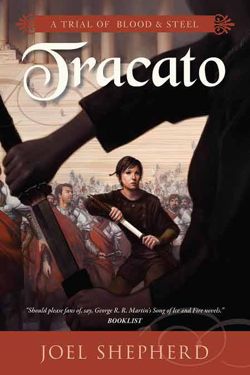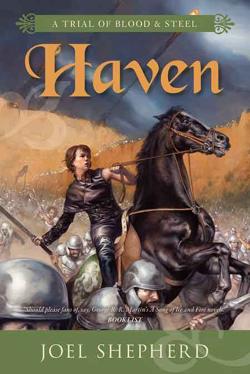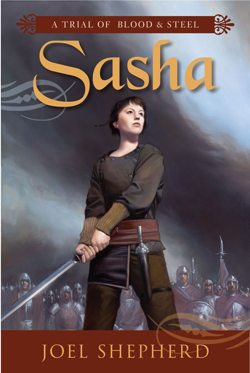As it’s been well over a year since Tor.com has given some love to Joel Shepherd’s excellent fantasy series A Trial of Blood and Steel, and since its fourth and final novel Haven is due out later this month, I thought it was time to highlight this absurdly under-appreciated series again.
If you’re looking for a solid fantasy series that’s low on magic and high on morally ambiguous characters and complex politics in the vein of George R.R. Martin’s A Song of Ice and Fire (to which Joel Shepherd’s series has been compared by many reviewers), look no further.
The land of Lenayin is spiritually divided into two different religions. The Goeren-yai faith, which is the original Lenay religion and embraced by most of the common people, has a pagan flavor. Its adherents seek the guidance of spirits and are first and foremost focused on strength and honor. By contrast, the Verenthane belief, which is followed by most of Lenayin’s nobility and several of the country’s powerful neighbors, more closely resembles a traditional organized religion. As Sasha, the first novel in the series starts off, the sole remaining Goeren-yai High Lord in Lenayin kills a neighboring province’s Verenthane leader, which sets off a complex conflict that threatens to destroy the fragile balance keeping Lenayin together.
 Enter the novel’s fascinating heroine, Sasha (short for Sashandra), a younger daughter of the Lenay king who has abandoned her royal privileges to live among the Goeren-yai and study svaalverd fighting techniques with Kessligh, the hero of a past war with neighboring Cherrovan. She has also adopted the Nasi-Keth, a third belief system that follows the rational teachings of the non-human serrin.
Enter the novel’s fascinating heroine, Sasha (short for Sashandra), a younger daughter of the Lenay king who has abandoned her royal privileges to live among the Goeren-yai and study svaalverd fighting techniques with Kessligh, the hero of a past war with neighboring Cherrovan. She has also adopted the Nasi-Keth, a third belief system that follows the rational teachings of the non-human serrin.
Sasha, the first book in the series, is a bit deceptive because it focuses almost exclusively on the conflict between the Goeren-yai and the Verenthanes in Lenayin, a land that only takes up 5% or so of the book’s map. While this conflict becomes an integral part of A Trial of Blood and Steel’s overall plot, the real focus of the series is the Verenthanes’ desire to “liberate” the Saalshen Bakosh, a set of provinces that were occupied by the serrin during a past war and are now flourishing, thanks to rational serrin policies such as emphasizing education and abandoning feudal rule.
As the series progresses, you learn that large parts of the civilized world consider the Lenays barbarians, but because they happen to be fearsome warrior barbarians, the Verenthanes need their help in their crusade against the serrin—even if most of the Lenay common people are Goeren-yai, don’t care one bit about the Verenthane faith, and really don’t have much of a problem with the serrin in the first place. Sasha quickly finds herself tangled in a complex web of loyalties, torn between her sense of duty to her royal family on the one hand, and her friendships with the common Goeren-yai people of her country and the serrin and Nasi-Keth on the other. The fact that none of these factions are morally perfect makes her position even harder.
 A Trial of Blood and Steel places complex characters in a complex setting, and then lets them resolve their issues without resorting to magic or prophesies. The serrin have a vaguely telepathic spiritual connection with each other, but aside from this there’s barely anything that could be considered supernatural in these books. Even the religions never show any sign of being based on real gods or spirits, which is ironic because they’re the root cause of (or rather, the excuse for) most of the conflicts.
A Trial of Blood and Steel places complex characters in a complex setting, and then lets them resolve their issues without resorting to magic or prophesies. The serrin have a vaguely telepathic spiritual connection with each other, but aside from this there’s barely anything that could be considered supernatural in these books. Even the religions never show any sign of being based on real gods or spirits, which is ironic because they’re the root cause of (or rather, the excuse for) most of the conflicts.
Sasha is an interesting protagonist. She’s a supremely talented sword fighter, but her gender and her family background lead many to underestimate her or discount her abilities, which then makes her train even harder and get even better at what she does. She’s also stubborn, highly temperamental and more than a little full of herself, so she doesn’t always respond as tactfully as she could to people who challenge her. One of the pleasures of reading A Trial of Blood and Steel is watching Sasha gradually mature and learn to apply one of the svaalverd’s main concepts—balance—to more than just swordfights.
Another strength of the series is the way it gradually widens the scope and ratchets up the intensity. By the time you get to Tracato, the tension has been dialed up to the maximum: the history of the various countries and religions is known, the characters are in place, and everything is inexorably converging. The first time I read Tracato was such a tense experience that I accidentally almost tore the book in half because I was holding it in such a death grip. It’s a textbook example of how to structure a fantasy series. Based on this, I’m starting to think that my expectations for series closer Haven (due out April 26th) may be unrealistically high, but the first three books in this series are some of my favorite fantasy novels of the last few years, so I’m hoping for a strong finish.
 Before A Trial of Blood and Steel, Joel Shepherd wrote the excellent Cassandra Kresnov SF trilogy. On the surface, the two series couldn’t look more different. One is fantasy, the other SF. One focuses on a sword-wielding princess, the other on an android. But at the same time, they’re more similar than you’d think: both series feature realistic, complex and strong female protagonists who are dealing with conflicted loyalties and ethical quandaries. Both series don’t shy away from exploring politics and morals in great detail, but they’re also full of some of the most hair-raising action scenes I’ve read in years. Both offer complex fictional universes, using them as more than just window-dressing and instead making them a central part of the plot. Another author who does this trick very effectively is Peter F. Hamilton, and while Shepherd doesn’t quite have Hamilton’s level of mastery yet, he’s already managed to produce two great series—and he’s only in his mid-thirties. I’m definitely keeping an eye on this guy.
Before A Trial of Blood and Steel, Joel Shepherd wrote the excellent Cassandra Kresnov SF trilogy. On the surface, the two series couldn’t look more different. One is fantasy, the other SF. One focuses on a sword-wielding princess, the other on an android. But at the same time, they’re more similar than you’d think: both series feature realistic, complex and strong female protagonists who are dealing with conflicted loyalties and ethical quandaries. Both series don’t shy away from exploring politics and morals in great detail, but they’re also full of some of the most hair-raising action scenes I’ve read in years. Both offer complex fictional universes, using them as more than just window-dressing and instead making them a central part of the plot. Another author who does this trick very effectively is Peter F. Hamilton, and while Shepherd doesn’t quite have Hamilton’s level of mastery yet, he’s already managed to produce two great series—and he’s only in his mid-thirties. I’m definitely keeping an eye on this guy.
Stefan Raets is a reviewer for Fantasy Literature. He lives in San Diego.










